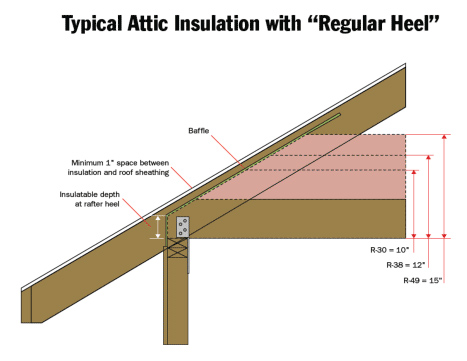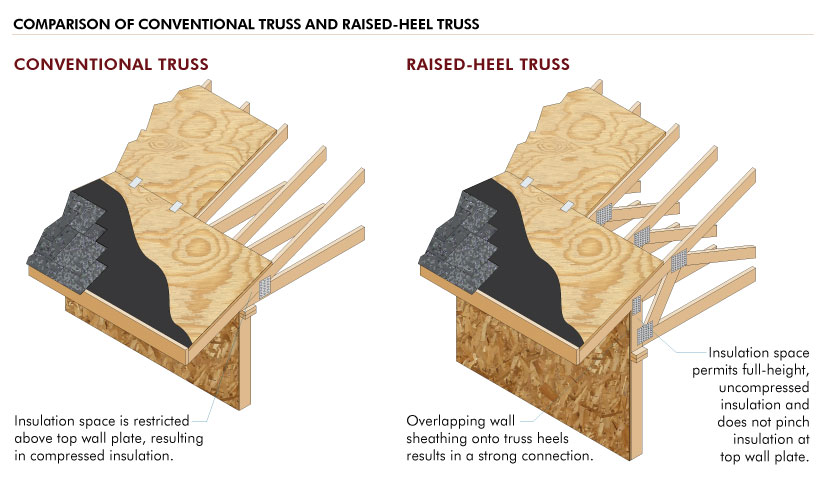This will work better with the plywood gussets than a narrow upright. Click and drag to draw a roof truss.
Rather than pinching your insulation down to 4 at the wall a.

. If you want a truss design that is high on energy efficiency then raised heel is a good option. 1 TPI 1-2014 2 2015 IRC Section R202. Building is designed in accordance with the IRC.
The guide can be downloaded for free from the APAs website. Regardless of which roof truss design you choose youll find that you can either have the trusses premade or assembled on site. Builders dont need special tools or know-how to build with them.
Standard Heel Typical truss heel height is about 4. Roof trusses can be designed with raised heel heights often called energy heels to allow for more insulation at the roof edge. Raised Heel Truss Family Help.
Special scissors truss dropped gable end cantilevered truss dual pitch truss cambered truss stub end raised heel vaulted ceiling truss dual pitch half scissor mono scissor half scissor clearstory truss attic frame truss shed porch piggy back attachment mono pitch all trusses are custom-built to meet your job specifications. Printed copies are available for 2. This is created by designing the truss with a heel height tall enough to meet the R value requirements.
Ad Industrys Trusted Guide For Machinery Parts Supplies Services. Vaulted parallel chord trusses are used wherever a steep interior vaulted ceiling is desired. 100 Free to Use.
A raised-heel truss is much like it sounds. Raised-Heel Truss Truss Heel Height The vertical depth of the truss at the outside face of the bearing. This helps with natural airflow.
The truss design helps with condensation problems in humid regions with the members placed in a way that it creates a vapor barrier. In cold areas it helps prevent ice dams by keeping the roof cold. In this situation the eave soffit is now higher up on the outside of the house.
We suggest the raised heel truss which allows for excellent ventilation and insulation. The members of the truss are insulated which does drive up costs but protects them from the environment. Using the Select Objects tool select the roof truss and then use the Open Object edit button.
The Option 1 figure to the right shows a raised energy heel. Ad Used In Clearspan Situation Can be Gable Or Single Slope. Raised-heel trusses differ from their conventional truss counterparts in that they are fitted with a heel where the bottom chord intersects with the perimeter wall plate which raises the top chord.
We use energy heel trusses and not canterlevered trusses. Raised heel trusses make a home more energy efficient by correcting an inherent problem with conventional attic framing. These roofs are slightly higher than others.
When a heel block in not provided throughout the combined height of the raised heel and the bottom chord member it. Design a cantilever heel. Easy to build with.
This results in extra space at the eaves which in turn provides enough space for full depth insulation in key areas above the ceiling. I will use a common truss design with plywood gussets and the block raising the heel will be a 2x12 3 12 high at the outer edge of the top plate. This is achieved through a raised heel that allows for the webs to transfer loads through the truss to the bearings.
Is a term used for the block installed between roof truss heels at the top of the exterior wall. Our passive solar house designs typically have a 4 roof overhang and we use Bruce Dana perforated metal soffit material that is fastened directly to the 2x6 truss tails. Though extra material is used to create the trusses raised design the extra cost can be offset by the need for less insulation without compromising energy efficiency.
In working on the Professional Remodeler Model Remodel project with builder Ben Bogie one phase was rolling trusses and Ben specified raised heel trusses to keep the thick layer of insulation in the attic wellTHICK. Vaulted parallel chord trusses have an identical top and bottom chord pitch. Ad Shop Roofing Today Get Great Deals On Quality Products.
Heel height is the depth of the attic space at the eavesthe vertical distance from the top plate to the underside of the roof sheathingmeasured at the outside wall. Raised-heel trusses are engineered utilizing advanced design and manufacturing techniques to meet modern building codes. The top of the top chord is 20 above our top plate.
According to the 2012 International Residential Code for seismic zones or zones designated for winds of 100 mph raised heel trusses more than 1525 have to be blocked and braced. Standard Truss Figure 2. Raised-heel trusses 9-14 to 15-14 inches in depth.
Also the raised-heel trusses are assumed to have a heel height of between 9¼ inches to 15¼ inches. If prompted that the layer Framing Roof Trusses is not displayed click Yes to turn on the display of this layer in the current view. In hot places it helps the AC unit not have to work overtime.
Trusses allow for simplified construction with lower waste but they have other advantages as well. The heel of a conventional plated roof truss where the bottom chord intersects with and bears on the perimeter wall plate and is fitted with a vertical member that literally raises the top chord of the truss. Heel Block Bird Block E Block.
This is especially helpful for homes that are more likely to experience ice damning. To build the energy heel truss Click Build Framing Roof Truss from the menu. A raised heel roof truss separates or raises the top chords or top edges of the truss from the bottom chord.
Start Your Project Sooner with Store Pickup. The heel height can be static so long as the distance from base of bottom chord to intersection of exterior edge vertical web and the base of top chord is held at 1 4. Call American Buildings Today.
Find the Right Material For Every Job. The truss span is only ten feet so according to the Hawaii County building code I do not need a professional design and stamp. Is it possible to get this family to have a slope parameter to dictate the Peak instead of the truss height value.
Raised Energy Heel Typical truss heel height is about 12 but may be designed to most any height per the Building Designer specification. The primary advantage of raising the heel is to allow full-depth uncompressed wall-to-wall insulation of the attic floor. Ventilation eave baffles if needed for air flow.
With this type of energy heel the wall sheathing will usually need to extend up the outside of the truss. We like the finished look better and we prefer to minimize vented cavity volume to avoid trapped moisture issues. We installed raised-heel trusses with bottom chord overhangs on our house.
Raised-heel trusses are installed the same as conventional trusses. The rafters dont leave enough heel height at the eaves for full depth-insulation.

Raising The Roof With Raised Heel Trusses

Keen On Green Building Design Giving Your Home A Good Hat Roof Truss Design Green Building Design Design

Raised Heels Structural Building Components Association

Raised Heel Trusses Apa The Engineered Wood Association
Raised Heel Trusses Improve Energy Performance Remodeling

Raised Heel Scissor Truss Scissor Truss Garage Shop Plans Frames On Wall

Raised Heel Roof Truss Explained More Energy Efficient Home Building Ideas Youtube

Raised Heel Trusses Make Better Enclosures Greenbuildingadvisor

0 comments
Post a Comment